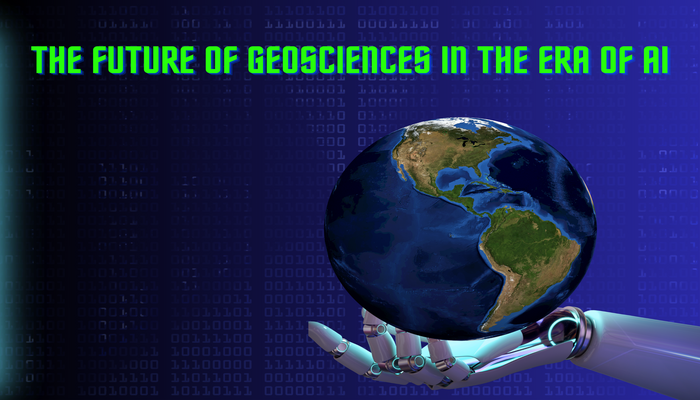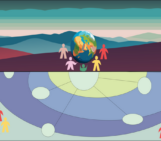
We live in the very heart of the Digital Age, where Artificial Intelligence (AI) is already playing a dominant role in our world. We have to ask ourselves what the future will hold for the field of Geosciences in the next years to come? In this week’s blog, our main goal is to share our views regarding the benefits and risks of AI in Geosciences.
We live in an ever-evolving world, where technology has transformed our daily activities with major breakthroughs. Every day a new technological advancement is on the horizon to make our living a little easier.
Especially, now more than ever, being at the forefront of the Technological Revolution and its impact on our society has brought into the spotlight ‘the new talk of the town’: Artificial Intelligence. This new powerful technological tool has already been used in various fields aiming to solve complex problems and provide the best solutions for our society (Ouadfeul et al., 2022).
However, despite its many supporters, there are also many sceptics about the applications of AI that eventually could pose a great risk to the safety of our planet as we know it.
But first, why don’t we take a closer look at the applications of AI in Geosciences, and see how can we make the most of it?
As aforementioned, AI is one of the most promising technologies of the century, and its use has gained more and more ground in Earth Sciences over recent years. This great influence of AI can be used in numerous fields of Geosciences, such as Geophysics, Seismology, Hydrology, Planetary Science, Remote sensing, as well as in Disaster Risk Reduction (Wang & Morra, 2021). Therefore, it is vital to understand its wider application in so many different areas of the Earth Sciences that enables us to provide better estimates and solutions to some of the most challenging issues.
AI Benefits
One of the main reasons that AI is so popular, especially among the Geoscientific community, is because it gives us the opportunity to analyse and assess large sets of information within a very short time in an effort to understand the most complex processes of our Earth system (Hickmon et al., 2022). Consequently, it can contribute to a great extent in this field by making efficient estimations and predictions using algorithms and other AI-enabled technologies, such as machine learning to investigate different patterns between data sources (Verdu et al., 2023).
According to a recent study from Brown University and MIT, a number of scientists explained how they accomplished to combine statistical algorithms using AI and machine learning with an eye to forecast scenarios and estimate extreme events in a much more efficient way compared to the traditional ones. In particular, they have developed a statistical model based on deep neural operators that allows them to acquire more information and improve the efficiency of data computation (Pickering et al., 2022).
Potential AI Risks
On the other hand, what could go wrong with AI? Have we ever wondered what would be the consequences of misusing or even overusing such a tool in a field of science, which studies a variety of chaotic and variable to extreme procedures?
To answer these critical questions, it is vital to understand that we live in an era of unprecedented innovation, and these innovations can prove fatal as they are still in their early stages of development and could affect our society.
One of the biggest risks of AI in the field of Geosciences is the lack of fairness, and accountability when it comes to data analysis and data acquisition. Hence, it is of utmost importance to ensure the safe application of technology in order to produce unbiased and reliable results. Otherwise, such practices could signify severe ethical implications within the scientific community and beyond (Sun et al., 2022).
Another potential risk of AI is to be used for causing harm, and not for the benefit of our world. For example, many scientists are motivated to use their expertise in the best interest to provide enhancements for our environment, however, when things go out of control and malevolent individuals try to gain access to confidential information, then the consequences can be catastrophic for our human evolution (Centre for the study of Existential Risk, 2018).
The Future of AI in Geosciences
Without a doubt, the future of AI seems boundless. Being at the very heart of the most rapidly changing digital environment that we ever faced, gives us the opportunity to use AI for the benefit of our planet. As discussed earlier, AI has a great potential to address complex issues in a very short time by combining the right computational methods to produce the best outcome.
However, despite the many advantages of using AI, there are also plenty of risks that could jeopardise the workings of our society and the ethical boundaries of science. Therefore, it is crucial to ensure the safe application of AI in the field of Geosciences and beyond with an aim to help advance our society, as well as protect our environment. As Stephen Hawking said in his speech at the Web Summit in 2017 ‘’Perhaps we should all stop for a moment and focus not only on making our AI better and more successful, but also on the benefit of humanity’’. Hence, it is up to us to ensure the safe and fair application of AI and make a difference in this world.
References Centre for the study of Existential Risk. (University of Cambridge). (2018). Risks from Artificial Intelligence. https://www.cser.ac.uk/research/risks-from-artificial-intelligence/ Hickmon, N., Varadharajan, C., Hoffman, F., Wainwright, H., & Collis, S. (2022). Artificial Intelligence for Earth System Predictability (AI4ESP) (2021 Workshop Report). https://doi.org/10.2172/1888810 Ouadfeul, S. A., Jawak, S. D., Shirzadi, A., & Idrees, M. O. (2022). Editorial: Artificial intelligence and machine learning in Earth science. Frontiers. https://doi.org/10.3389/feart.2022.1090016 Pickering, E., Guth, S., Karniadakis, G. E., & Sapsis, T. P. (2022). Discovering and forecasting extreme events via active learning in neural operators. Nature Computational Science, 2(12), 823–833. https://doi.org/10.1038/s43588-022-00376-0 Sun, Z., Sandoval, L., Crystal-Ornelas, R., Mousavi, S. M., Wang, J., Lin, C., Cristea, N., Tong, D., Carande, W. H., Ma, X., Rao, Y., Bednar, J. A., Tan, A., Wang, J., Purushotham, S., Gill, T. E., Chastang, J., Howard, D., Holt, B., & Gangodagamage, C. (2022). A review of Earth Artificial Intelligence. Computers & Geosciences, 159, 105034. https://doi.org/10.1016/j.cageo.2022.105034 Verdu, E., Nieto, Y. V., & Saleem, N. (2023). Big data and artificial intelligence in earth science: recent progress and future advancements. Acta Geophysica, 71(3), 1373–1375. https://doi.org/10.1007/s11600-023-01051-2 Wang, H., & Morra, G. (2020). Artificial Intelligence in Geosciences. Artificial Intelligence in Geosciences, 1, 52–53. https://doi.org/10.1016/j.aiig.2021.02.001





